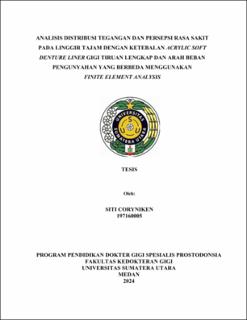| dc.contributor.advisor | Nasution, Ismet Danial | |
| dc.contributor.advisor | Sabri, M | |
| dc.contributor.author | Coryniken, Siti | |
| dc.date.accessioned | 2025-05-15T02:29:05Z | |
| dc.date.available | 2025-05-15T02:29:05Z | |
| dc.date.issued | 2024 | |
| dc.identifier.uri | https://repositori.usu.ac.id/handle/123456789/103798 | |
| dc.description.abstract | Edentulous or loss teeth causes a loss of integrity in the function of the
masticatory system which is also accompanied by a decrease in phonetic and aesthetic
function, as well as loss of periodontal support. Complete dentures (GTL) is still the
main choice to replace and restore this function. However, the use of GTL is often
associated with failure rates and discomfort caused by alveolar bone resorption and
loading patterns of mastication that change from tensile to compressive with axial and
oblique mastication load directions. The knife-edge ridge or sharp ridge is one of the
alveolar resorption in the mandible which often causes complaints because the sharp
ridge has a narrow alveolar ridge and acts as a fulcrum point during mastication,
resulting in denture instability and uneven stress distribution from the masticatory load.
If this condition is not treated, it will cause further resorption of the remaining alveolar
ridge and can cause the perception of pain that exceeds the pressure pain threshold
(PPT). Treatment that can be done is to reline the GTL using acrylic soft denture liner
(ASDL). This material has a cushion effect which can distribute the masticatory load
evenly and can test in silico with finite element analysis. This study aims to analyze
the distribution of stress and pain perception in sharp edges with different ASDL
thicknesses and directions of masticatory load. The method used in this research is
finite element analysis (FEA). The results show that complete dentures without using
a soft denture liner (ASDL) from the axial and oblique directions have the highest stress
distribution concentration value, when associated with pain perception the value
exceeds the average pressure pain threshold (PPT) value (average PPT value 0.630
MPa). Meanwhile, the use of ASDL thicknesses of 1 mm, 2 mm and 3 mm in the axial
direction shows the ability to absorb and distribute stress evenly with the highest
concentration value not exceeding the average PPT value so that it does not cause the
perception of pain. In the oblique direction, ASDL with a thickness of 1 mm shows the
ability to absorb and distribute stress evenly with a concentration value that does not
exceed the average PPT value so it does not cause the perception of pain. However,
ASDL thicknesses of 2 mm and 3 mm in the oblique direction show the highest stress
concentration values which are quite large and exceed the average PPT value, causing
pain. Based on the results of this research, it can be concluded that the lowest value of
the highest stress concentration is the use of 1 mm ASDL in the direction of axial and
oblique masticatory loads, where the value is below the average pressure pain threshold
(PPT) value (0.630 MPa) so that does not cause the perception of pain. The use of
ASDL with a thickness of 1 mm is recommended for GTL with sharp edges to reduce
pain perception due to masticatory pressure. | en_US |
| dc.language.iso | id | en_US |
| dc.publisher | Universitas Sumatera Utara | en_US |
| dc.subject | stress distribution | en_US |
| dc.subject | pressure pain threshold (PPT) | en_US |
| dc.subject | axial | en_US |
| dc.subject | oblique | en_US |
| dc.subject | finite element analysis | en_US |
| dc.title | Analisis Distribusi Tegangan dan Persepsi Rasa Sakit pada Linggir Tajam dengan Ketebalan Acrylic Soft Denture Liner Gigi Tiruan Lengkap dan Arah Beban Pengunyahan yang Berbeda Menggunakan Finite Element Analysis | en_US |
| dc.title.alternative | Finite Element Analysis of Stress Distribution and Pain Perception on Knife-Edge Ridge with Complete Denture in Varioussoft Denture Liner and Masticatory Load’s Direction | en_US |
| dc.type | Thesis | en_US |
| dc.identifier.nim | NIM197160005 | |
| dc.identifier.nidn | NIDN0031084802 | |
| dc.identifier.nidn | NIDN0023066305 | |
| dc.identifier.kodeprodi | KODEPRODI12707#Prostodonsia | |
| dc.description.pages | 129 Pages | en_US |
| dc.description.type | Tesis Magister | en_US |
| dc.subject.sdgs | SDGs 3. Good Health And Well Being | en_US |


